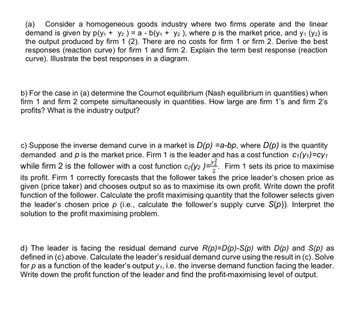(a) Consider a homogeneous goods industry where two firms operate and the linear demand is given by p(y₁ + y² ) = a - b(y₁ + y2 ), where p is the market price, and y₁ (y²) is the output produced by firm 1 (2). There are no costs for firm 1 or firm 2. Derive the best responses (reaction curve) for firm 1 and firm 2. Explain the term best response (reaction curve). Illustrate the best responses in a diagram. b) For the case in (a) determine the Cournot equilibrium (Nash equilibrium in quantities) when firm 1 and firm 2 compete simultaneously in quantities. How large are firm 1's and firm 2's profits? What is the industry output?
(a) Consider a homogeneous goods industry where two firms operate and the linear demand is given by p(y₁ + y² ) = a - b(y₁ + y2 ), where p is the market price, and y₁ (y²) is the output produced by firm 1 (2). There are no costs for firm 1 or firm 2. Derive the best responses (reaction curve) for firm 1 and firm 2. Explain the term best response (reaction curve). Illustrate the best responses in a diagram. b) For the case in (a) determine the Cournot equilibrium (Nash equilibrium in quantities) when firm 1 and firm 2 compete simultaneously in quantities. How large are firm 1's and firm 2's profits? What is the industry output?
Chapter1: Making Economics Decisions
Section: Chapter Questions
Problem 1QTC
Related questions
Question
a and b thanks

Transcribed Image Text:(a) Consider a homogeneous goods industry where two firms operate and the linear
demand is given by p(y₁ + y2) = a - b(y₁ + y2), where p is the market price, and y₁ (y2) is
the output produced by firm 1 (2). There are no costs for firm 1 or firm 2. Derive the best
responses (reaction curve) for firm 1 and firm 2. Explain the term best response (reaction
curve). Illustrate the best responses in a diagram.
b) For the case in (a) determine the Cournot equilibrium (Nash equilibrium in quantities) when
firm 1 and firm 2 compete simultaneously in quantities. How large are firm 1's and firm 2's
profits? What is the industry output?
Expert Solution
This question has been solved!
Explore an expertly crafted, step-by-step solution for a thorough understanding of key concepts.
Step by step
Solved in 6 steps with 1 images

Follow-up Questions
Read through expert solutions to related follow-up questions below.
Follow-up Question
Please answer part C and D - As answered earlier the first two parts with ery clear solutions with clear steps and explainantion. Please do not answer if you are not confident.

Transcribed Image Text:(a) Consider a homogeneous goods industry where two firms operate and the linear
demand is given by p(y₁ + y2) = a - b(y₁ + y2), where p is the market price, and y₁ (y₂) is
the output produced by firm 1 (2). There are no costs for firm 1 or firm 2. Derive the best
responses (reaction curve) for firm 1 and firm 2. Explain the term best response (reaction
curve). Illustrate the best responses a diagram.
b) For the case in (a) determine the Cournot equilibrium (Nash equilibrium in quantities) when
firm 1 and firm 2 compete simultaneously in quantities. How large are firm 1's and firm 2's
profits? What is the industry output?
c) Suppose the inverse demand curve in a market is D(p) =a-bp, where D(p) is the quantity
demanded and p is the market price. Firm 1 is the leader and has a cost function c₁(y₁1)=cy₁
while firm 2 is the follower with a cost function c₂(y2 )=2. Firm 1 sets its price to maximise
its profit. Firm 1 correctly forecasts that the follower takes the price leader's chosen price as
given (price taker) and chooses output so as to maximise its own profit. Write down the profit
function of the follower. Calculate the profit maximising quantity that the follower selects given
the leader's chosen price p (i.e., calculate the follower's supply curve S(p)). Interpret the
solution to the profit maximising problem.
d) The leader is facing the residual demand curve R(p)=D(p)-S(p) with D(p) and S(p) as
defined in (c) above. Calculate the leader's residual demand curve using the result in (c). Solve
for p as a function of the leader's output y₁, i.e. the inverse demand function facing the leader.
Write down the profit function of the leader and find the profit-maximising level of output.
Solution
Knowledge Booster
Learn more about
Need a deep-dive on the concept behind this application? Look no further. Learn more about this topic, economics and related others by exploring similar questions and additional content below.Recommended textbooks for you


Principles of Economics (12th Edition)
Economics
ISBN:
9780134078779
Author:
Karl E. Case, Ray C. Fair, Sharon E. Oster
Publisher:
PEARSON

Engineering Economy (17th Edition)
Economics
ISBN:
9780134870069
Author:
William G. Sullivan, Elin M. Wicks, C. Patrick Koelling
Publisher:
PEARSON


Principles of Economics (12th Edition)
Economics
ISBN:
9780134078779
Author:
Karl E. Case, Ray C. Fair, Sharon E. Oster
Publisher:
PEARSON

Engineering Economy (17th Edition)
Economics
ISBN:
9780134870069
Author:
William G. Sullivan, Elin M. Wicks, C. Patrick Koelling
Publisher:
PEARSON

Principles of Economics (MindTap Course List)
Economics
ISBN:
9781305585126
Author:
N. Gregory Mankiw
Publisher:
Cengage Learning

Managerial Economics: A Problem Solving Approach
Economics
ISBN:
9781337106665
Author:
Luke M. Froeb, Brian T. McCann, Michael R. Ward, Mike Shor
Publisher:
Cengage Learning

Managerial Economics & Business Strategy (Mcgraw-…
Economics
ISBN:
9781259290619
Author:
Michael Baye, Jeff Prince
Publisher:
McGraw-Hill Education